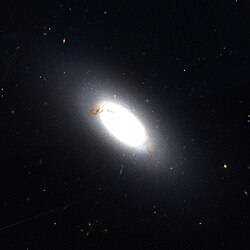astro.wikisort.org - Galaxy
NGC 3156 is a lenticular galaxy located in the constellation Sextans.[5][6][7] It is located at a distance of about 75 million light-years from Earth and is forming a pair with NGC 3169. It was discovered by astronomer William Herschel on October 13, 1784.[8]
| NGC 3156 | |
|---|---|
 NGC 3156 by Hubble Space Telescope | |
| Observation data (J2000 epoch) | |
| Constellation | Sextans |
| Right ascension | 10h 12m 41.24591s[1] |
| Declination | +03° 07′ 45.6939″[1] |
| Redshift | 0.00415[2] |
| Helio radial velocity | 1242 km/s[2] |
| Distance | 72.67 ± 0.46 Mly (22.28 ± 0.14 Mpc)[3] |
| Apparent magnitude (V) | 12.30[4] |
| Apparent magnitude (B) | 13.07[4] |
| Characteristics | |
| Type | S0[4] |
| Other designations | |
| UGC 5503, MCG +01-26-019, PGC 29730[2] | |
It is a member of the NGC 3166 Group of galaxies, which is a member of the Leo II Groups, a series of galaxies and galaxy clusters strung out from the right edge of the Virgo Supercluster.[9][10]
Gallery
- NGC 3156 (SDSS DR14)
 NGC 3156 (HST)
NGC 3156 (HST)
References
- Brown, A. G. A.; et al. (Gaia collaboration) (August 2018). "Gaia Data Release 2: Summary of the contents and survey properties". Astronomy & Astrophysics. 616. A1. arXiv:1804.09365. Bibcode:2018A&A...616A...1G. doi:10.1051/0004-6361/201833051. Gaia DR2 record for this source at VizieR.
- "NGC 3156". SIMBAD. Centre de données astronomiques de Strasbourg. Retrieved 2021-02-18.
- Tully, R. Brent; et al. (2013). "Cosmicflows-2: The Data". The Astronomical Journal. 146 (4). arXiv:1307.7213. Bibcode:2013AJ....146...86T. doi:10.1088/0004-6256/146/4/86.
- "Search specification: NGC 3156". HyperLeda. Université Claude Bernard Lyon 1. Retrieved 2021-02-18.
- Stone, Nicholas C.; van Velzen, Sjoert (2016-06-30). "An enhanced rate of tidal disruptions in the centrally overdense E+A galaxy NGC 3156". The Astrophysical Journal. pp. L14. doi:10.3847/2041-8205/825/1/L14. Retrieved 2020-09-27.
- "(PDF) Central regions of the early-type galaxies in the NGC 3169 group". ResearchGate. Retrieved 2020-09-27.
- "A Preferred Home for Disrupted Stars". aasnova.org. American Astronomical Society. Retrieved 2020-09-27.
- Seligman, Courtney. "New General Catalogue objects: NGC 3150 - 3199". cseligman.com. Retrieved 2021-02-18.
- "The Leo III Groups". Atlas of the Universe. Archived from the original on July 22, 2012. Retrieved 2010-11-27.
- "NAME NGC 3166 Group". SIMBAD. Centre de données astronomiques de Strasbourg. Retrieved 2021-02-18.
External links
 Media related to NGC 3156 at Wikimedia Commons
Media related to NGC 3156 at Wikimedia Commons
На других языках
[de] NGC 3156
NGC 3156 ist eine Linsenförmige Galaxie vom Hubble-Typ S0 im Sternbild Sextant am Südsternhimmel. Sie ist schätzungsweise 53 Millionen Lichtjahre von der Milchstraße entfernt und hat einen Durchmesser von etwa 30.000 Lichtjahren. Die Galaxie gilt als Mitglied der fünf Galaxien zählenden NGC 3169-Gruppe (LGG 192). Im selben Himmelsareal befinden sich u. a. die Galaxien NGC 3165 und NGC 3166.- [en] NGC 3156
[ru] NGC 3156
NGC 3156 (другие обозначения — UGC 5503, MCG 1-26-19, ZWG 36.57, PGC 29730) — линзообразная галактика (S0) в созвездии Секстанта. Открыта Уильямом Гершелем в 1784 году[3].Текст в блоке "Читать" взят с сайта "Википедия" и доступен по лицензии Creative Commons Attribution-ShareAlike; в отдельных случаях могут действовать дополнительные условия.
Другой контент может иметь иную лицензию. Перед использованием материалов сайта WikiSort.org внимательно изучите правила лицензирования конкретных элементов наполнения сайта.
Другой контент может иметь иную лицензию. Перед использованием материалов сайта WikiSort.org внимательно изучите правила лицензирования конкретных элементов наполнения сайта.
2019-2025
WikiSort.org - проект по пересортировке и дополнению контента Википедии
WikiSort.org - проект по пересортировке и дополнению контента Википедии

